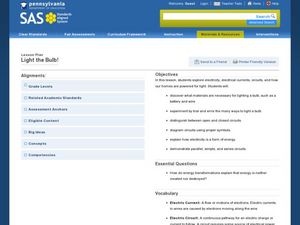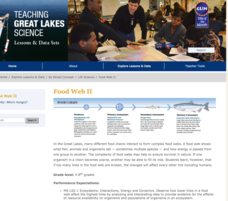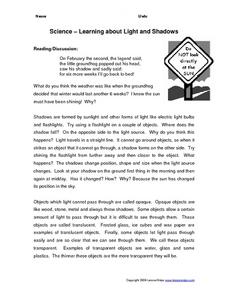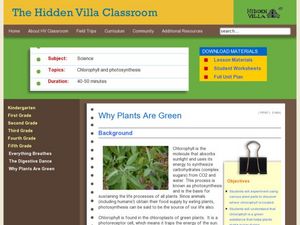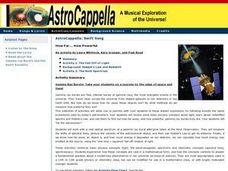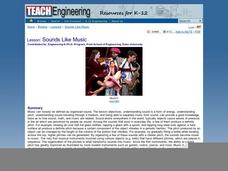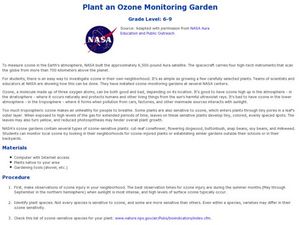Curated OER
The Phenomenon of Sound: Waves
Students explore sound waves. In this sound waves lesson, students brainstorm different sounds and how sounds move or travel. Students then create a KWL chart and work through six different lab activities to examine how sound waves...
Curated OER
The Discovery of Photosynthesis
Young scholars explore how scientists discover photosynthesis. In this biology instructional activity, students identify the basic requirements for photosynthesis to happen. They recreate past scientists' experiments and record their...
Curated OER
Plate Tectonics
Students research separate elements of the theory of Plate Tectonics, then share that information with each other, drawing conclusions from the culminated information.
Curated OER
Chemiluminescence
Students explore chemiluminescence through various experiments. In this chemistry lesson plan, students explain the chemical reaction that drives the process. They give real life applications of chemiluminescence.
Pennsylvania Department of Education
Light the Bulb!
Third graders investigate electrical circuits and how light bulbs are powered. In this electricity and power lesson, 3rd graders study the vocabulary necessary which includes the different types of circuits, electrical currents, and...
Curated OER
Calculating Black Hole Power
In this black hole activity, learners use a given equation that relates the rate of matter falling into a black hole to the power emitted by the black hole to determine accreted mass.
Curated OER
Food Chains and Food Webs
Fourth graders study intertidal organisms and their role in the food web. In this food web lesson, 4th graders read the book The Sea That Feeds Us and discuss food webs. Students study pictures of intertidal creatures and discuss their...
Michigan Sea Grant
Food Web II
A food web consists of complex food chains and the more complex the web, the better likelihood of survival. Learners compare and contrast food webs and food chains and discuss concepts like the predator-prey and consumer-producer...
Curated OER
WHAT MAKES A LIGHT BULB LIGHT?
Young scholars are able to use inquiry to answer the essential questions. They are able to predict and test configurations of a battery, bulb, and wire that make the complete circuit. Students craft a group and individual theory of a...
Curated OER
Science--Learning About Light and Shadows
In this light and shadows worksheet, students find 5 transparent items and 5 opaque items from the classroom and categorize them underneath their appropriate headings. Students look at 4 boxes with shadows and draw a little sun to show...
Curated OER
Fit With Fiber
Sixth graders investigate the nutritional value of different types of cereal. They take a survey of students that ate breakfast and create a circle graph with the results. Students examine the nutritional information on the sides of the...
Curated OER
Chemistry of Food
In this chemistry of food worksheet, students complete 20 various types of questions related to food and nutrition. First, they complete a crossword puzzle with vocabulary terms. Then, students use the figure shown to write the...
Curated OER
Why Plants Are Green
Students discover the properties of chlorophyll in plants. In this plant biology lesson, students conduct an experiment to find where the chlorophyll in the plant is located. Students are split into small groups and study plant parts....
Curated OER
Glucose
High schoolers conduct various experiments on glucose. In this biology lesson, students differentiate the process of diffusion and osmosis. They test different foods for the presence of glucose and starch.
Curated OER
The Power of Persuasion
Students explore the power of persuasion. In a classroom setting, students discuss incentives, testimonials and deceptive pricing schemes that are used to influence others. After observing professionally made infomercials, students...
Curated OER
Biological Relationships - Coral Reef Memory Game and Chain Game
Middle schoolers familiarize themselves with the interconnectedness of species within an ecosystem, and to use this knowledge to evaluate how the removal or decimation of one species can have far reaching effects.
Curated OER
How Far... How Powerfu
Students work with a real optical spectrum of a gamma ray burst afterglow taken at the Keck Observatory. They measure the shifts of spectral lines, deduce the velocity of the astronomical object, and then use Hubble's Law to get its...
Curated OER
National Biodiesel Day
In this National Biodiesel Day instructional activity, students complete activities such as reading a passage, phrase matching, fill in the blanks, correct words, multiple choice, spelling, sequencing, scrambled sentences, writing...
Curated OER
I See a Coyote
Students role-play coyotes looking for natural resources. For this natural resources lesson, students examine the relationship between animal life and the environment. Students play a game that demonstrates how natural...
Curated OER
Eating Through the Metric System
Seventh graders convert measurements in recipes to metric measurements and prepare the food items. They create a metric measurement cookbook.
Curated OER
Sounds Like Music
Students define and examine the connections between sound and music and how engineers design instruments. They listen to examples of musical instruments, view a demonstration of a tuning fork and bottles filled with varying amounts of...
Curated OER
Exploring for Petroleum - Modeling an Oil Reserve
Learners experiment with locating oil reserves. In this conservation activity, students use a cardboard box to create sand, rocks, and an oil reserve (water balloon). They use a probe to dig around in the box to find the oil reserve and...
Curated OER
Modeling an Oil Reserve
Students conduct an experiment. In this oil and natural gas lesson, students learn how geoscientists identify and explore reserves of petroleum. Students make a model of an oil reserve, record how much it would cost to drill...
Curated OER
Plant an Ozone Monitoring Garden
Students create a garden. In this ozone lesson, students discuss ozone injury, identify plants sensitive to ozone, and then plant their own ozone garden.




